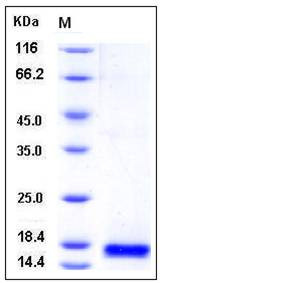Mouse PLA2G2E Protein (His Tag)
RP23-352K10.7
- 100ug (NPP3445) Please inquiry
| Catalog Number | P50687-M08H |
|---|---|
| Organism Species | Mouse |
| Host | Human Cells |
| Synonyms | RP23-352K10.7 |
| Molecular Weight | The secreted recombinant mouse PLA2G2E comprises 134 amino acids and has a calculated molecular mass of 15.5 kDa. The apparent molecular mass of the recombinant protein is approximately 18 kDa in SDS-PAGE under reducing conditions. |
| predicted N | Asn 20 |
| SDS-PAGE |  |
| Purity | > 97 % as determined by SDS-PAGE |
| Protein Construction | A DNA sequence encoding the mouse PLA2G2E (Q9QUL3) (Met 1-Cys 142) was expressed, with a C-terminal polyhistidine tag. |
| Bio-activity | |
| Research Area | Signaling |Signal Transduction |Metabolism |Types of disease |Metabolism in Cancer |
| Formulation | Lyophilized from sterile PBS, 10% glycerol, pH 7.4 1. Normally 5 % - 8 % trehalose, mannitol and 0.01% Tween80 are added as protectants before lyophilization. Specific concentrations are included in the hardcopy of COA. |
| Background | Mouse Group IIE secretory phospholipase A2, also known as GIIE sPLA2, sPLA2-IIE, Phosphatidylcholine 2-acylhydrolase 2E and PLA2G2E is a secreted protein which belongs to the phospholipase A2 family. Mammalian secretory phospholipase A2s ( sPLA2s ) form a family of structurally related enzymes that are involved in a variety of physiological and pathological processes via the release of arachidonic acid from membrane phospholipids or the binding to specific membrane receptors. Phospholipases A2 / PLA2 are enzymes that release fatty acids from the second carbon group of glycerol. This particular phospholipase specifically recognizes the sn-2 acyl bond of phospholipids and catalytically hydrolyzes the bond releasing arachidonic acid and lysophospholipids. Phospholipases A2 / PLA2 are commonly found in mammalian tissues as well as insect and snake venom. Venom from both snakes and insects is largely composed of melittin, which is a stimulant of Phospholipases A2 / PLA2. Due to the increased presence and activity of Phospholipases A2 / PLA2 resulting from a snake or insect bite, arachidonic acid is released from the phospholipid membrane disproportionately. As a result, inflammation and pain occur at the site. PLA2G2E catalyzes the calcium-dependent hydrolysis of the 2-acyl groups in 3-sn-phosphoglycerides. Has a preference for arachidonic-containing phospholipids. |
| Reference |
